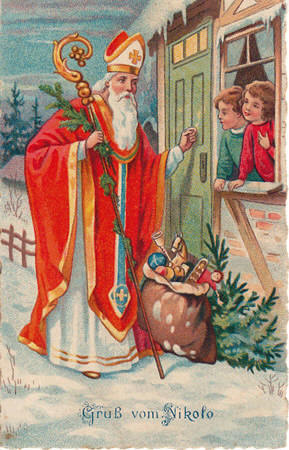
December 25 is not Jesus’ birthday. Christmas is based on the winter solstice. In a great many religions from the Old World, the solstice marked the day that the vegetation god died, typically by being crucified on a tree, causing all the earth’s vegetation to die with him only to be reborn on the spring equinox. Thus the death and resurrection of the god symbolized the death and resurrection of vegetation throughout the year.
None of the gospels give an exact date for the birth of Jesus. The Gospel of Luke mentions shepherds out tending sheep in the late evening, which some have taken to mean it wouldn’t be in the winter since sheep would have been locked up. Luke puts his birth at 6 A.D., a symbolic year for Jewish resistance as Luke specifically makes reference to the Roman tax census that triggered a revolt by Judas the Galilean (a Zealot figure who probably inspired Judas Iscariot, seeing how his surname is a reference to Sicarii assassins). The Gospel of Matthew tells the story of the Three Magi visiting Herod the Great on their way to meet baby Jesus, but Herod didn’t die until 4 B.C., a full 10 years before the tax census.
Around 200 A.D., St. Clement of Alexandria gave three different dates various churches used to celebrate Jesus’ birthday. None of them were December 25. Another Alexandrian theologian named Origen mocked Roman celebrations of birth anniversaries, dismissing them as “pagan” practices.
Tertullian, the first Latin father to mention the Trinity, in particular condemned decorating the home with boughs of evergreen, saying:
“Let them over whom the fires of hell are imminent, affix to their posts, laurels doomed presently to burn: to them the testimonies of darkness and the omens of their penalties are suitable. You are a light of the world, and a tree ever green. If you have renounced temples, make not your own gate a temple.”
Even the 2,600-year-old Biblical prophet Jeremiah condemned a ritual seemingly identical to Christmas, saying: “For the customs of the peoples are worthless; they cut a tree out of the forest, and a craftsman shapes it with his chisel. They adorn it with silver and gold; they fasten it with hammer and nails so it will not totter” (10:3-4).
The first Christian linking Jesus’ birth to Christmas comes from an Egyptian in the mid-300s, and by the late 360s, the Donatists, an African Christian sect that broke away from the “traitors” who allied themselves with Emperor Constantine, accepted Christmas on December 25 but not the Epiphany on January 6.
Some time during the Middle Ages, the Christmas tree became associated with the tree from the Garden of Eden, called the “Paradise Tree,” and decorated with apples, a concept hardly alien from the original pre-Hebrew myth. The first recorded Christmas tree was erected in the house of a military brotherhood in Estonia in the mid-1400s. A Bremen guild chronicle of 1570 records how a small tree decorated with apples, nuts, dates, pretzels and paper flowers was put up in the guild house for the members’ children. Most Christmas trees were found only in churches until the 1500s, but even in the mid-1800s, they were still controversial enough to bring threats against Henry Schwan of Cleveland Ohio, the first American pastor to erect a Christmas Tree in his church. The Puritans likewise condemned Christmas, with Oliver Cromwell outright banning “the heathen traditions” of Christmas carols, decorated trees and any joyful expression that desecrated “that sacred event.” Martin Luther tried replacing the bearer of gifts with Christkindl, the “Christ Child”, but the name was only transferred over to St. Nikolaos, which is why Santa Claus is also known as “Kriss Kringle.” Decorating the tree with expensive-for-the-time candles comes from the 1700s and by the 1800s Christmas trees were showing up in Germany’s schools, inns, and military hospitals.
The winter solstice was important in ancient times because there was little food and starvation was common, so the solstice was meant to be the last feast celebration before everyone had to hole themselves up for winter. Most cattle were slaughtered to save on food, so the solstice feast was one of the few times anyone could eat as much meat as they wanted. Wine and beer stored for fermentation was opened up at this time. The reason Christmas Eve holds particular importance is because the pre-Romanized day began in the evening previous, just as the Jewish Sabbath does today.
In Roman times, the solstice festival was named Saturnalia after the god of time and agriculture. According to the third-century Neo-Platonic philosopher Porphyry, Saturnalia occurred near the winter solstice because the sun enters Capricorn, the astrological house of Saturn, at that time. The holiday was celebrated with a sacrifice at at Saturn’s temple and a public banquet followed by private gift-giving.
There was a carnival atmosphere, complete with costumes and role-playing, a time when social norms could be overturned: gambling was permitted, no declaration of war could be made, and masters provided table service for their slaves. Both citizen and slave wore the cone-shaped pileius cap, representing the wearer as a freedman. The reversal of social roles aspect of the holiday was inherited from the Athenian festival of Kronia, named after Kronos (linked to the root word “chron,” as in “chronology” or “chronicle”), the Greek equivalent of Saturn, although the Greek holiday was actually celebrated in the summer.
Wikipedia says that:
The day of gift-giving was the Sigillaria on December 23. Because gifts of value would mark social status contrary to the spirit of the season, these were often the pottery or wax figurines called sigillaria made specially for the day, candles, or “gag gifts”, of which Augustus was particularly fond. In his many poems about the Saturnalia, Martial names both expensive and quite cheap gifts, including writing tablets, dice, knucklebones, moneyboxes, combs, toothpicks, a hat, a hunting knife, an axe, various lamps, balls, perfumes, pipes, a pig, a sausage, a parrot, tables, cups, spoons, items of clothing, statues, masks, books, and pets. Gifts might be as costly as a slave or exotic animal. Patrons or “bosses” might pass along a gratuity (sigillaricium) to their poorer clients or dependents to help them buy gifts. Some emperors were noted for their devoted observance of the Sigillaria.
The revelries and dropping of social status of Saturnalia were supposed to reflect the conditions of the lost mythical age, when Saturn, or Kronos, reigned over the world during a time of limitless bounty of the earth without labor in a state of social egalitarianism known as the Golden Age, the same as the Biblical Eden.
The Jewish Talmud ascribes the origins of this festival to Adam, who saw that the days were getting shorter and became afraid that the world was returning to the chaos and emptiness that existed before creation because of his sin, and so fasted for 8 days, representing the 8 days between Saturnalia and the winter solstice. When the days grew long again, he realized it was the earth’s natural cycles, and so made 8 days of celebration, representing the 8 days between the soltice and the festival called Kalend. Only later was the festival turned into something pagan, according to the text.
Christmas day also marked the first day of the year for the Anglo-Saxons, the German tribes that invaded Great Britain in the 400s and ruled the newly dubbed Angle-land (England) until the Norman conquest in 1066. Around 730 A.D., the venerable Latin monk Bede wrote:
They began the year with December 25, the day some now celebrate as Christmas; and the very night to which we attach special sanctity they designated by the heathen term Modraniht, that is, the mothers’ night — a name bestowed, I suspect, on account of the ceremonies they performed while watching this night through.
In Germany, the Yule festival was celebrated for 12 days from late December to early January on a date determined by the lunar Germanic calendar. The legendary Ynglinga Saga, written by the Old Norse Icelandic poet Snorri Sturloson in 1225, mentions a Yule feast being celebrated as early as 840. In the Saga of Hákon the Good, Snorri gives a vivid description of the German festival:
It was ancient custom that when sacrifice was to be made, all farmers were to come to the heathen temple and bring along with them the food they needed while the feast lasted. At this feast all were to take part of the drinking of ale. Also all kinds of livestock were killed in connection with it, horses also; and all the blood from them was called hlaut [sacrificial blood], and hlautbolli, the vessel holding the blood; and hlautteinar, the sacrificial twigs [aspergills]. These were fashioned like sprinklers, and with them were to be smeared all over with blood the pedestals of the idols and also the walls of the temple within and without; and likewise the men present were to be sprinkled with blood. But the meat of the animals was to be boiled and served as food at the banquet. Fires were to be lighted in the middle of the temple floor, and kettles hung over them. The sacrificial beaker was to be borne around the fire, and he who made the feast and was chieftain, was to bless the beaker as well as all the sacrificial meat.
The first toast was to be drunk to Odin “for victory and power to the king,” the second toast to Njörðr and Freyr “for good harvests and for peace,” the third toast was to be a beaker drunk to the king himself, with final toasts to the memory of departed kinsfolk.
Children would fill their boots with carrots, straw, or sugar and place them near the chimney for Odin’s flying gray horse, Sleipnir, to eat. Black ravens would listen from the chimney hole in the house to figure out which children were naughty and which were nice before the large white-bearded Odin would enter and reward the good children by replacing Sleipnir’s food with gifts or candy. Thor, whose home was in the snowy “Northland”, also rode a flying chariot pulled by two white goats, Cracker and Gnasher, and came down the chimney holes directly into the fire, which was his natural element.
St. Nikolaos’ popularity skyrocketed during Medieval times. The propensity of paintings of Nikolaos was matched only by the Virgin Mary, with almost 400 churches dedicated to him in England during the late Middle Ages. The earlier Yule-themed traits of Odin and Thor passed on to the German Sinterklaas since the Feast of St. Nikolaos was on December 6. This may be related to the fact that the 6th of each month was considered the birthday of the goddess Artemis, the same goddess many of the temples that St. Nikolaos had destroyed was dedicated to. After the Protestant Reformation, Nikolaos’ popularity dwindled in the west, except in the Netherlands. The image of Santa being a fat man comes from the Dutch-American poet Clement Moore in 1823, although Coca Cola ads helped trim his wild nature beard and dropped the smoking pipe.
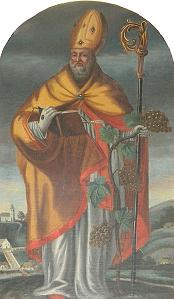
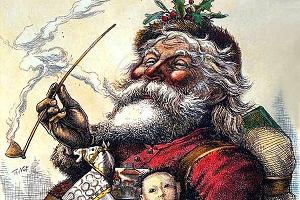
St. Nikolaos was originally from Myra in Asia Minor, but his remains were taken to Mari in southern Italy in 1087, and by the late 1400s the city was in control of Spain, which was part of the Moorish Empire of African-Arab Muslims. This is why in the mid-1800s, Dutch folklore described the companions of Sinterklaas, “Zwarte Pieten”, or “Black Petes,” as little Moorish children. These “helper elves” were said to navigate the steam boat that took Sinterklaas from Spain to the Netherlands and took the role of the black crows in listening from the chimney holes and stuffing presents down the ones who had good children. Sinterklaas’ giant bag contained not just candy for nice children but a chimney sweep’s broom to spank naughty children, and some of the older Sinterklaas songs even say the bag was used to carry naughty children back to Spain. In Belgium, “Black Petes” still dress up in colorful moorish clothing and scatter pepper nuts, spice nuts, and special Christmas candies called “strooigoed” to those who ran into Sinterklass as he went around town.
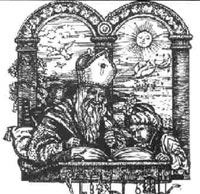
The relation between Sinterklaas and Black Pete also mirrors the relationship between Amoo Nowruz (“Uncle New Day”), a white-bearded “Father Time” figure who brings gifts on the eve of the Spring Equinox, and Hajji Firuz, little black-faced, red-suited harbingers of the Persian New Year. These soot-covered tambourine players are believed to come from the tradition of the “Mir-Norowzi,” a comical figure that was paraded around the city and given the power of being king for five days.
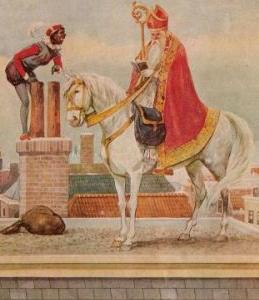
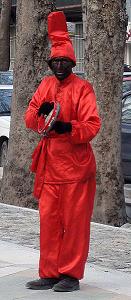
Left: Black Pete and Sinterklaas; Right: Hajji Firuz
The red clothes and soot-covered faces and red clothes of the Hajji Firuz apparently goes back to the red-dressed fire-keepers of the Zoroastrians, who at the last Tuesday of the year, was sent by the Zoroastrian priests to spread the news about the arrival of the New Year and call on the people to renew their lives by burning their old items in the fire. The dualistic religion of Zoroastrianism seems to have contributed to the concept of armies of angels and demons doing battle with one another in Christianity since nothing in the Old Testament gives the Judaic Satan from Job that kind of power or authority. And in fact, other Alpine folktales tell of Sinterklass’ companion being the devil, who was shacked to him and made his slave, which fostered the concept of the satyr-like Krampus of Austrian lore. Sources from Germanic Europe identify Black Pete and the Sinterklaas’ demonic slave as being one and the same.
Like Batman, Nikolaos the Confessor used the inheritance from his tragically deceased parents to help the needy. Although Santa passing out candy can be traced back to Odin, the tradition is more popularly linked with the legend of St. Nikolaos sneaking golden coins into the homes of three impoverished families through the windows in order to prevent the desperate families from having to sell their daughters into prostitution for food. Other 11th-century legends tell how he was able to identify a butcher who murdered three children (or inn residents) and was trying to sell their butchered remains as ham, and then resurrected the children. Another legend says that after convincing sailors taking wheat to Emperor Constantine to donate some to the famine-hit people in the city of Mysa that they would not suffer for it, the sailors found that the wheat weighed the same after arriving at Constantinople. Another legend says that Nikolaos set sail for Jerusalem, but after having a Satanic dream, he prophecized a storm and then, a la Jesus, halted the storm and resurrected a sailor who had been blown off a mast. In Jerusalem, church doors magically opened for him, but having not stollen Jesus’ bit enough, he went into the desert to pray but was called back to Mysa so that he could walk through the church doors at just the right time to fulfill a vision given to one of the church elders that an bishop position should be given to the person to next walk through the door.
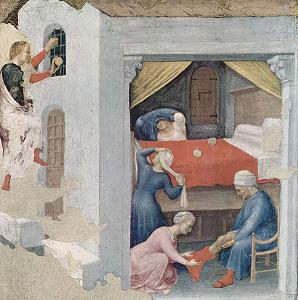
Although St. Nikolaos is not listed among the debaters at the famed Council of Nicaea, there is another legend that he passionately debated with the theologian Arius over whether Jesus was one and the same in God or a creation of God. Arius argued that the title “Son of God” insinuated inferiority to the Father, saying, “What argument then allows, that He who is from the Father should know His own parent by comprehension? For it is plain that for that which hath a beginning to conceive how the Unbegun is, or to grasp the idea, is not possible.”
And for that, jolly ol’ Saint Nick bitch-slapped him.
Nikolaos was kicked out from the council and Constantine threw him in prison, so says the legend, but then Jesus and the (now official) Mother of God vindicated him. In dreams, of course. The dreams brought the priests and bishops to Constantine begging to let pimp daddy Santa out of prison, which Constantine did after he saw Nikolaos produce both gospel and bishop garments from within his cell. So I guess the lesson here is it is completely all right to resort to violence to prove abstract theological points that even Constantine loathed.
Another similar legend says that Nikolaos helped stop one of Constantine’s armies from sacking the city and then saved three generals from being executed by appearing in a dream to Constantine, who rewarded the three men with golden gospels and incense burners, making St. Nick the patron saint of the falsely accused.
The afore-mentioned 13th-century Icelandic poet Snorri credits the 10th-century King Haakon I of Norway with being the first to combine the Yule festival with Christmas. Although Haakon kept his Christian religion secret at first, he eventually wielded enough power to request a bishop and priests from England to convert the country. By the 1200s or early 1300s, Yule became equated with Christmas, with The Grettis Saga saying that all Christians fasted from meat the day before Yule in preparation of the feast.
In the 1100s A.D., a marginal note written by a Syrian Biblical commentator, Dionysius bar-Salibi, said that Christmas had been moved from January 6 to December 25 so that it fell on the same date as the holy day for the pagan Sol Invictus, the Roman version of the Zoroastrian-inspired sun god Mithras that Constantine had worshiped. His birthday was also December 25. Macrobius, one of the last fifth-century Latin authors not to convert to Christianity, said that the proximity of the Saturnalia to the winter solstice led to an exposition of solar monotheism, the belief that Sol Invictus ultimately encompasses all divinities as one.
Some Biblical scholars have suggested that the date for Christmas was actually determined by calculating the date back 9 months from Passover to the day of his conception, the Annunciation, under the assumption that early Christians were following a Jewish tradition that creation (the Nativity) and redemption (the Crucifixion) occurred at the same time, but Passover and the Annunciation are also derived from the Spring Equinox, or Easter.
The Canaanite fall harvest was changed by the Israelites into Succoth, when they were to move into booths in remembrance of the Exodus, and the Canaanite New Year festivals became Rah ha-Shanah and Yom Kippur, the day of repentance. The Semitic early spring festivals which celebrated the birth of the new lamb became historicized into the Passover, when the blood of lambs was to be put on doorposts.
Even the very minor celebration of Hanukkah probably only showed up on Jewish calendars to provide some kind of a substitute for the winter festival of their neighbors. As David Frum points out, the Pharisee sect that eventually became Orthodox Judaism was actually in contention with the Maccabbees who miraculously held out against the Syrians by the power of divinely enduring lamp oil since the Maccabees not only took over the throne of Jerusalem but also the priesthood, breaking the Biblical law that only Levites could be priests. Since the whole rebellion was based around having to sacrifice against the rules of the Bible, it was understandably a controversy. (Not to mention the fact that the Maccabees allied against the Syrians with the Romans, the same guys who eventually burned down the Temple and put an end to Jewish sacrifice forever.)
The name Easter is based on the Saxon goddess Eostre, which is also related to the word “east” because the sun rises in the east, representing the resurrection of the sunlight. She is also equivalent to the Greek Aphrodite and the Roman Venus, whose lover Adonis is also crucified to a tree and was resurrected in the Spring. Fertility symbols such as the highly reproductive bunny and the egg became associated the rebirth of new life that comes in the spring.

In Norse mythology, the vegetation god Baldr (of Baldur’s Gate fame) is killed by a dart made from mistletoe and just like Jesus in the apocryphal Gospel of Nicodemuis, goes to Hel(l) to be resurrected during the Norse Apocalypse, called Ragnarok. Baldr had visions of his own death, as did his mother Frigg, wife to Odin, so Frigg forced all things on the earth to vow not to hurt Baldr except for the mistletoe, so of course, mistletoe became his kryptonite. After being shot by a mistletoe dart by his blind brother Hodr, who is sometimes guided by Loki, Frigg made an arrangement with the queen of the underworld, Hel, to release Baldr if everything in the world wept for him, but a female giant named Thokk, which some sources say was Loki in disguise, refused to weep for him, and thus prevented his resurrection.
Mistletoe is actually a parasite that grows off the branches from bird droppings and thrives during the winter, making it a suitable scapegoat for the destruction of vegetation during that time. Pre-Christian Europe viewed mistletoe as a representation of divine male fertility, possibly because its berries look like semen. Somewhere along the line this turned into kissing under the mistletoe.
The weeping for Baldr also mirrors the ceremonial “weeping for Tammuz,” which many women from Jerusalem did during the 7th century B.C., much to the prophet Ezekiel’s own chagrin (8:14). The symbol of Tammuz was the Tau cross, from which we get the letter T from. In Sumerian times, he was known as Dumuzi (literally “Good Son”), the Crucified Bread and Beer God who rose on Easter and was known as both “Shepherd” and “Fisherman.”
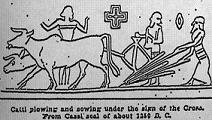
Sumerian Cylinder From Nippur linking the plowing of grain with the Tau cross.
Dumuzi’s lion-riding wife Inanna was known in the Akkadian language as Ishtar, which is probably related etymologically with Eostre. In Canaan she was known as Asherah, and the Old Testament violently condemns those who worshipped her Asherah poles which symbolized the Tree of Life on which her lover was crucified on. Not only is there a long theological history behind associating Jesus’ cross with the Tree of Life, but infact other than the four gospels and a couple of very late pseudographical epistles attributed to Paul in the late second century, the New Testament refers only to Jesus being “hung on a tree.” The “Sacred Marriage” held between Dumuzi and Inanna was the subject of much erotic Sumerian poetry, which is mirrored in the Biblical Song of Solomon. There are several myths concerning Dumuzi’s tragic death, but the longest one involves him being taken by demons while sitting beneath a tree and then hung on a stake in the netherworld. A Mesopotamian cylinder seal dated between 2320 and 2150 B.C. shows a multi-horned Inanna welcoming Dumuzi back from the dead from the bottom of a tree. Sumerian statues of Inanna also look very much like the ancient “Venus figurines” like the “Venus of Willendorf,” earth mother figurines discovered throughout all of the Old World and dated as far back as 27,000 years ago.
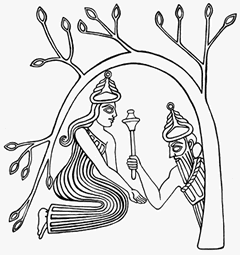
The Babylonians also celebrated the New Year Zagmuk festival of sowing barley in March/April, complete with the Christmas traditions of exchanging gifts, carnival processions, twelve-day feasts, and the staged re-enactment of the Enuma Elish creation myth. Each year as winter arrived, it was believed that the ancient seawater and freshwater monsters of chaos who gave birth to all the gods tried to slay their creations, and so in turn, the freshwater Apsu was tamed by the Promethean god Ea (or Enki) while it was the head god of the Babylonian pantheon, Ba’al Marduk, who battled and slew his primordeal wife Tiamat, before fashioning her corpse into the known world. Tiamat, who in Sumerian myths was Nammu, the great mother of both the universe and humankind, is probably another incarnation of the primordeal “Venus” earth mother. Thus, the Babylonian creation myth apparently represents the replacement of the far more ancient matrimonial religion with that of the patriarchal storm god cult.
The king of Babylon acted out the part of Marduk in the ceremonial New Years play. On the 10th day of the ceremony, he would enact the Sacred Marriage rite with his spouse or a celebate high priestess. In some versions of the story, Marduk is killed by Tiamat and then saved by his son Nabu, the god of writing, so in the enactment of the ritual, the king’s life was to be forfeited as well. However, a prisoner was usually used as a scapegoat for the king, and just to make it fair, a different prisoner was set free under some twisted sense of “balance.” Philo tells of a similar story of a madman named “Carabbas” dressed up and hailed as a mock king, and it is this story combined with the ancient myth of the sacrificed king that inspired the story of Pontius Pilate releasing Barabbas because of a non-existent Jewish custom of releasing a prisoner that the Romans would certainly never had honored even if it did exist. The tradition of the “mock king” holds parallels with some of the other cultural Christmas traditions as it follows the same themes as the dropping rank in Saturnalia and the five-day rule of the Mir-Norowzi. Even in late medieval England, St. Nicholas’ Day parishes held Yuletide “boy bishop” celebrations in which young men performed the functions of priests and bishops and were allowed to boss around their elders.
The myth of Hodr blindly slaying Baldr is mirrored in the apocryphal Book of Jasher in which the antediluvian king Lamech blindly shoots Cain with an arrow by the malevolent direction of his son Tubal-Cain, angering Lamech enough so that he then turned and killed his son in frustration as well. The story of Cain and Abel itself is based on an earlier Sumerian myth about two brothers, Summer and Winter, contending which of their sacrifices was more appealing to their father Enlil, and like the story of Cain (“Metal Smith”) and Abel (a possible pun on “Herdsman”), one is a farmer and one a shepherd, highlighting the ancient conflict between city farmers and nomadic shepherds. Just as Cain represented the city farmer and Abel the shepherd, Tubal-Cain is said in Genesis to have forged the first tools in bronze and iron while his brother Jubal was the father of the harp and flute for the “jubilee.” Just as Romulus slew Remus, Cain killed his brother Abel and was then banished to the land of Nod (“wandering”) and built the first city Enoch, which in Mesopotamia was Eridu. Later Kassite myth said that the first priest of Eridu, Adapa, was taken up to heaven where he met Dumuzi and Gizzida (“Good Tree,” Dumuzi’s double from the city of Lagash) playing St. Peter at the Pearly Gates, after which Adapa, on the advice of the wise God Enki playing the role of the snake in the Garden of Eden, denied the sky god Anu’s offer of the bread and water of eternal life, mirroring the Biblical interpretation of the Fall of Man and the story of the Biblical Enoch being taken up into heaven.
The second Sumerian capital city to take hold in ancient Sumer was Bad-Tibira (“The Fortress of Metal Smiths”), a natural identification for Tubal-Cain (“Bringer of Metal Smithery”), and the third king to rule the city was none other than Dumuzi the Shepherd. Another Dumuzi, called “the Fisherman,” ruled Uruk right before the famous king Gilgamesh. Since this Dumuzi captured the king to a rival dynasty in Kish that Gilgamesh was also in conflict with, it may be reasonable to link the fisherman Dumuzi with the tragic figure of Enkidu, who in Sumerian myth is blindly sent to the underworld by Gilgamesh only to be trapped there for not heeding Gilgamesh’s warnings. The Epic of Gilgamesh later absolves Gilgamesh of any guilt by placing the blame on Ishtar, just as Inanna is said to have been regretfully responsible for Dumuzi’s death in other versions of the Dumuzi myth. In yet another version, Dumuzi’s sister, Geshtinanna takes vengence on the storm goddess who killed Dumuzi, just as Ba’al Hadad’s sister/lover Anat takes revenge on the underworld god Mot for slaying her brother in a later Canaanite myth. In the Coptic Gospel of Judas, Egyptian Gnostics also rewrote the Passion story so that Judas betrayal of Jesus was a necessary part of some deeper cosmic mystery.
At the heart of this world myth lies the complimentary forces of good and evil, king and slave, and sacrifice and betrayal. The Persian historian and mythologist Mehrdad Bahar argued that the figure of the Haji Firuz is derived from ceremonies and legends connected to the Epic of Prince Siavash, which in turn derive from the ancient myths of Dumuzi, with the blackened face of the Hajji Firuz reaching back into the ancient symbolism of the vegetation god returning from the world of the dead, while his red clothing symbolized Siavash’s blood and the return of the sacrificed deity. His joviality, as with the Biblical Jubal, is the jubilation of Spring’s rebirth. The mothers of Baldr and Achilles, “the woman clothed in sun” in Revelation, and the Athena-like goddess of wisdom spoken of in the Toledot Yeshu all represent the same overarching theme of a protective mother or sister goddess watching over her Savior son/lover, who always dies tragically but is then reborn, whether it be Dumuzi, Tammuz, Adonis, Attis, Osiris, Dionysus, Baldr, or Jesus.